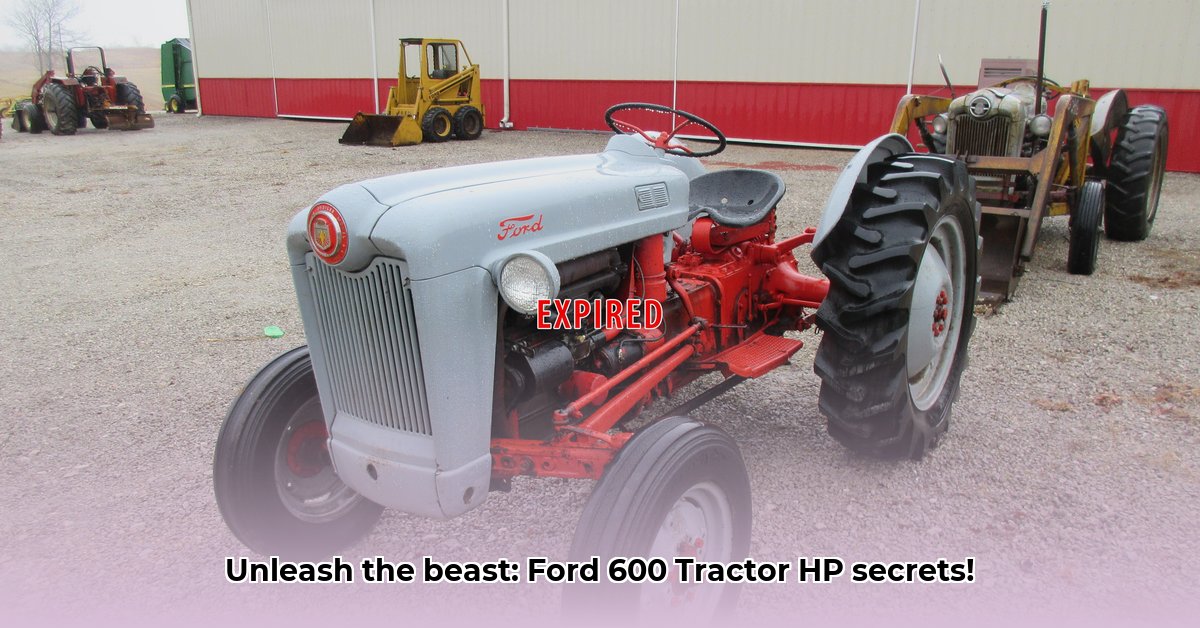
The Ford 600 series tractors, produced between 1954 and 1957, represent a significant chapter in Ford's agricultural machinery legacy. This guide delves into the horsepower variations across the 620, 630, 640, 650, and 660 models, exploring their technical specifications, performance capabilities, historical context, and enduring appeal among collectors. Understanding their power output is crucial for appreciating their role in shaping modern farming practices. For more Ford tractor models, check out this useful resource.
Technical Specifications: Decoding the "Red Tiger"
At the heart of each Ford 600 series tractor beat the renowned "Red Tiger" engine. While generally advertised around 31 horsepower, certain configurations pushed the output closer to 33 hp. However, horsepower alone doesn't tell the whole story. Transmission type, PTO (Power Take-Off) system—live or non-live—and hydraulic system design all contribute significantly to the tractor's overall performance.
| Model | Approximate Engine Horsepower | Transmission Type | PTO Type (Live/Non-Live) | Hydraulic System |
|---|---|---|---|---|
| 620 | 31 hp (approx.) | 4-speed manual | Non-live | Single-pump, basic lift capacity |
| 630 | 31 hp (approx.) | 4-speed manual | Non-live | Single-pump, basic lift capacity |
| 640 | 31 hp (approx.) | 4-speed manual | Live | Single-pump, improved lift capacity |
| 650 | 31 hp (approx.) | 4-speed manual | Live | Single-pump, improved lift capacity |
| 660 | 33 hp (approx.) | 5-speed manual | Live | Single-pump, highest lift capacity |
The difference between live and non-live PTO systems is critical. A live PTO allows implements to continue operating even with the tractor's clutch disengaged, boosting efficiency. A non-live PTO, however, requires the clutch to remain engaged for continued implement operation. This seemingly small difference significantly impacted the workflow for various agricultural tasks.
Performance and Capabilities: On-Field Assessment
While precise drawbar pull and fuel economy figures for each model are scarce, information available primarily focuses on the 640 model. Direct comparisons across all models are challenging due to the variations in transmission and other factors influencing performance. These tractors were designed for smaller farms or moderate-intensity tasks. Their size and maneuverability were valuable assets, compensating for their comparatively lower horsepower when compared to modern tractors.
Historical Context: A Piece of Farming History
The Ford 600 series represented a notable advancement in Ford's tractor lineup, building upon preceding models with enhanced features and improved functionality. While precise production numbers remain elusive, their popularity during their production years is well-documented, contributing to their current collector appeal.
Collector's Interest: A Growing Market
The Ford 600 series has experienced a surge in popularity amongst collectors. Factors influencing value include overall condition (well-maintained tractors command higher prices), rarity (certain model variations and configurations are more scarce), and originality (preserving original parts and features significantly impacts value).
Parts Availability and Maintenance: Keeping the Legacy Alive
Many parts for the Ford 600 series are still available, although sourcing some components might present challenges. Regular maintenance is paramount for preserving the tractor's operational integrity and extending its lifespan. Proactive maintenance significantly reduces the likelihood of costly repairs.
Conclusion: A Timeless Workhorse
The Ford 600 series tractors, despite their modest horsepower compared to modern agricultural equipment, hold a special place in history. Their simplicity, reliability, and growing collector’s market demonstrate their enduring appeal. These tractors encapsulate a bygone era of farming, showcasing a testament to robust engineering and functionality. Their legacy continues to resonate with both farmers and enthusiasts alike.